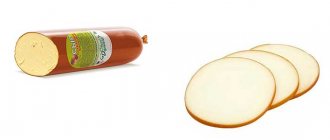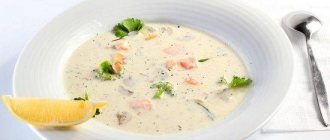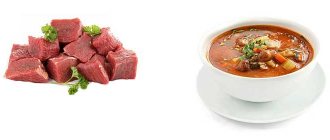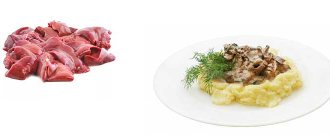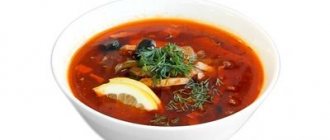Properties of pesto sauce
Nutritional value and composition | Vitamins | Minerals
How much does pesto sauce cost (average price for 1 jar)?
Moscow and Moscow region.
100 rub.
Pesto sauce is rightfully considered one of the classic or base sauces of Italian cuisine. In Italy, they are very sensitive to national culinary traditions, and pesto sauce can be considered a shining example of such respect and popular love. Pesto sauce got its name from the Italian word pesto or pestato, which literally means “to crush, trample or grind.” The name of pesto sauce indicates how the product is made.
Manufacturing Features
It is known that sauce can elevate any dish to a new level. Pesto is easy to prepare. The recipe is used by both professionals and inexperienced cooks.
Recommended reading: Health Benefits of Tofu Cheese
The method of producing the famous composition depends on its variety. To get the classic version you need:
- Peel and then chop the garlic.
- Wash the basil greens, dry them and chop finely.
- Grate Parmesan on a coarse grater.
- Add pine nuts to the mixture, then grind in a mortar or blender, add olive oil.
Pesto sauce is stored in the refrigerator
Important! The product is placed in glass containers.
Using pesto sauce
Initially, the product was used as a means of folk therapy. Gradually, the mass representing the sauce began to be actively used for culinary purposes. Pesto is consumed all over the world. The universal composition is added to appetizers, soups, salads, fish, meat dishes, and vegetables. It gives a bright and rich taste.
Ingredients of pesto sauce
The classic composition of pesto sauce includes ingredients such as olive oil, cheese, as well as green basil leaves and nuts. In order to get real Italian pesto sauce, you need to follow the recipe exactly. It is better to use a good variety of olive oil for the sauce. Parmesan and pecorino cheese are most often used for pesto. However, the modern composition of pesto sauce has undergone some changes. Modern chefs use green cheeses, which differ in taste, but add richer color and aroma to pesto sauce.
Pesto sauce was invented by the Italians, and this nation simply cannot imagine its life without tomatoes. Therefore, there is a subtype of tomato pesto sauce, which is distinguished by its rich red color rather than the classic green color. The recipe for red pesto sauce differs only in one ingredient - naturally sun-dried tomatoes. Red as well as green varieties of pesto sauce are widely used not only in Italian, but also in world cooking.
In its homeland in Italy, pesto sauce is considered an excellent addition to most national dishes. Italians make simple sandwiches from fresh white bread and pesto sauce. It is believed that the recipe for pesto sauce, like most classic European sauces, has been known since the times of the Roman Empire. The ancient Romans were gourmets and tirelessly invented new and more delicious dishes.
However, the first documentary evidence of pesto sauce dates back to the second half of the 19th century. This period of time is characterized by an increased interest of culinary specialists in ancient recipes. It was in that century that some other sauces were rediscovered. For example, the French classic bechamel or currency. Pesto sauce was first produced in European territory in the Liguria region.
Using only a marble mortar and wooden pestle, basil leaves, pine seeds and garlic were crushed. Ligurian olive oil, salt and pecorino cheese were then added. Cashews or walnuts served as cheaper substitutes for pine seeds, and pecorino was gradually replaced by parmesan. It is interesting that in several other countries there is an independent version of pesto sauce. For example, in Germany, wild garlic leaves are used instead of basil, and in Austria, pumpkin seeds are used.
Varieties of sauce
The Italian product is recognizable all over the world. It stands out among other sauces with its basil aroma, green color and exquisite taste. The inventors of the famous pesto are the Genoese. The following variants of the modern product are called:
- Sicilian, including fresh tomatoes;
- Pistachio, which contains nuts grown near Mount Etna;
- Trapanian, characterized by the inclusion of almonds and sun-dried tomatoes;
- Austrian, characterized by the presence of pumpkin seeds.
We recommend reading: Foods containing histamine: complete list + table
The German recipe uses wild garlic instead of basil. Fresh notes in different versions are provided by cashew nuts and hazelnuts.
Important! The product is considered a symbol of wealth. Not a single wedding in Italy is complete without sauce.
Classical
Pesto is a mixture of olive oil, basil, pine nuts, garlic, Parmesan or sheep cheese, and sea salt. Although there are other variations of the sauce, this type is the most common.
The classic sauce is made in a marble mortar
Red
The product is obtained by adding sun-dried tomatoes to the composition. The sauce has a rich hue and unique aroma.
Red pesto is combined with pasta, vegetables, meat and cream cheese
Yellow
To obtain the required shade of the famous sauce, other components are included in the composition. Ricotta is usually added to pesto. The variety is whey cheese. The sauce also contains walnuts.
Yellow pesto served with vegetable soups
Violet
The desired color of the sauce is obtained by adding the desired variety of basil. Usually the mass is also enriched with melted butter and arugula.
Purple pesto goes well with seafood, fish, baked potatoes
Selection in store
Gourmets already know that store-bought sauce is not like real Italian sauce. This is understandable - a commercial product contains only those ingredients that are commercially beneficial to the manufacturer. For example:
- Expensive pine nuts are replaced at best with cashews, at worst with peanuts.
- Instead of olive oil, you can find soybean or rapeseed oil in the composition.
- Salt, thickeners and flavorings compensate for the deficiency or complete absence of some natural ingredients.
On the Russian market, I consider Barilla basil pesto to be the best in terms of price/quality ratio. The sauce has a classic, balanced texture and a rich flavor, with nutty notes and the influence of premium hard Italian cheeses (Grana Padano and Pecorino Romano).
But even good industrial brands do not reach Italian standards in taste and aroma. This is partly due to the need to cook the basil, whereas a true Italian sauce is made from raw ingredients.
What should connoisseurs of real pesto do? Look for it in specialized stores at inflated prices, bring it from abroad, or cook it yourself at home.
Calorie calculation for 100 grams
As an example, we will calculate a portion equal to 100 grams - this is one of the standard weight measures that determines the total calorie content of a product or recipe.
The easiest and most versatile option (suitable for calculating any volume of a product or ready-made dish) is calculation by multiplying the resulting calorie content (250 grams) by a factor of 0.4, which is the result of division (100 g / 250 g).
Calorie content of 100 grams of serving = 1917.3 * 0.4 = 767 kcal.
In addition, in the same way you can calculate the content of BZHU in the composition of a portion:
- Protein = 26.17 * 0.4 = 10.468 ≈ 10.5 g.
- Fats = 198.39 * 0.4 = 79.356 ≈ 79.4 g.
- Carbohydrates = 6.77 * 0.4 = 2.708 ≈ 2.7 g.
10.5 * 4 + 79.4 * 9 + 10.8 * 4 ≈ 767 kcal
Our calculated calorie content is more than 250 kcal, which means that pesto pasta is a high-calorie dish, high in protein, fat and low in carbohydrates.
Related Products
Hoisin Sauce (220 cal) Fish Sauce (35 cal) Cheese Sauce (174 cal) Horseradish Sauce (503 cal) Chili Sauce (20 cal) Duck Sauce (245 cal) Soy Sauce (58 cal) ) Tomato sauce (79 cal) Spaghetti sauce (48 cal) BBQ sauce (166 cal) Pasta sauce (70 cal) Hot sauce (17 cal) Pizza sauce (54 cal) White sauce (72 kcal) Brown sauce (95 cal) Red sauce (30 cal) Alfredo sauce (535 cal) Salsa (34 cal) Cream sauce (146 cal) Seafood sauce (124 cal) Teriyaki sauce (89 (cal) Chipotle Sauce (12 cal) Prego Sauce (65 cal) Enchilada Sauce (33 cal) Green Taco Sauce (25 cal) Peanut Sauce (218 cal) Plum Sauce (184 cal) Sweet and Sour sauce (150 cal) Tartar sauce (211 cal) Worcestershire sauce (78 cal) Mushroom sauce (35 cal)
What are the benefits of sauce for the body?
Pesto inherited the key beneficial properties of its components: olive oil, nuts, basil leaves and high-quality hard cheese:
- Vegetable (from olive oil and nuts) and dairy (from cheese) fats promote the absorption of fat-soluble vitamins, stimulate regeneration, strengthen the immune system, and nourish nerve cells.
- The sauce saturates the body with proteins (proteins), which are involved in many biochemical processes of the body.
- Natural antioxidants, which are abundant in olive oil, basil and pine nuts, fight premature aging, prevent the destructive effects of oxidative stress, and prevent the development of serious diseases.
- The presence of dietary fiber allows you to satisfy hunger for a long time, eliminates cravings for sweets, stimulates intestinal peristalsis, and helps cleanse organs (including the liver) of poisons.
- Pesto exhibits antibacterial and anti-inflammatory properties, normalizes intestinal microflora.
- In reasonable quantities, the sauce is good for the heart - it reduces the level of “bad” cholesterol in the blood, strengthens vascular walls, and normalizes blood pressure.
- Maintains the beauty of skin (stimulates collagen production), hair (nourishes hair follicles) and nails.
- Polyunsaturated fats increase performance and endurance, so they are especially useful for athletes, scientists, and people with poor health.
- In winter, it replenishes the deficiency of vitamins and minerals (vitamins C and B, potassium, calcium, iron, zinc) in the body.
- Supports the nervous system during stressful situations, nourishing brain cells and activating internal reserves.
The benefits and harms of balsamic vinegar.
Contraindications and possible harm
Italian cuisine is considered the most aromatic in the world. It includes fragrant spices, exquisite seasonings and fiery garlic. Pesto sauce is a symbol of Italian cuisine. The popularity of the product is due to the unique and harmonious combination of the main ingredients.
Pesto sauce has beneficial properties. This is not only tasty, but also a valuable product. It includes components related to a healthy diet.
It should be remembered that pesto sauce has both benefits and harm. It is not recommended for use if you have allergic reactions to its ingredients. Contraindications also include diseases of the digestive system during an exacerbation.


